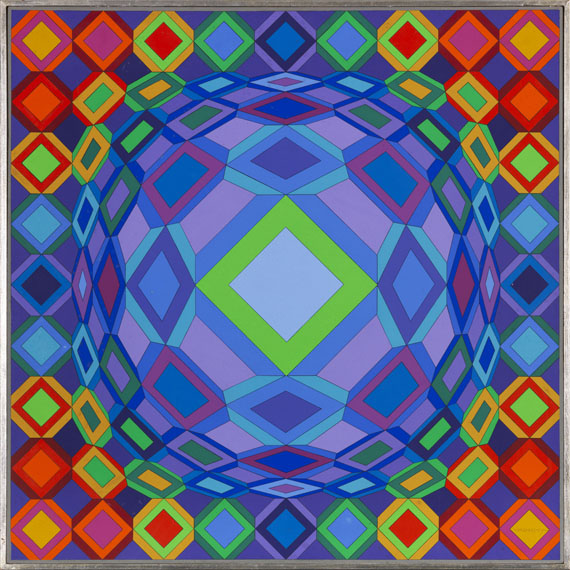336
Victor Vasarely
Niepes, 1973.
Acrylic on cardboard, mounted on panel
Estimate:
€ 60,000 / $ 70,800 Sold:
€ 68,750 / $ 81,125 (incl. surcharge)
Niepes. 1973.
Acrylic on cardboard, mounted on panel.
Signed in lower right. Verso of the panel twice signed (once in printed characters), dated, titled as well as inscribed "2709" and minimally differing dimensions. 73 x 73 cm (28.7 x 28.7 in).
• Typical colorful example of the artist's signature style geometric abstraction.
• Using rectangular forms only, Vasarely creates the illusion of a three-dimensional, seemingly hovering sphere.
• Victor Vasarely is both founding member and most important representative of Op-Art.
• Between 1955 and 1964 Vasarely participated in 4 documenta exhibitions.
Accompanied by a photo expertise from Pierre Vasarely, president of the Fondation Vasarely, universal legatee and holder of Victor Vasarely's moral rights, issued in May 2021. The artwork will be included in the forthcoming Catalogue Raisonné de l’Oeuvre Peint de Victor Vasarely, which is currently compiled by the Fondation Vasarely, Aix-en-Provence.
PROVENANCE: Private collection Sweden.
Private collection Southern Germany (Ketterer Kunst, Munich, May 8, 1999, lot no. 71).
LITERATURE: Ketterer Kunst, Munich, 230th auction, Modern Art, May 8, 1999, lot 71 (with color illu.).
"Hypnotic motifs, vibrant forms and flickering patterns: The master of optical illusion puts vision to the test."
From a text for the exhibition "Vasarely. Im Labyrinth der Moderne", Städel Museum, Frankfurt am Main, September 26, 2018 – January 13, 2019
Acrylic on cardboard, mounted on panel.
Signed in lower right. Verso of the panel twice signed (once in printed characters), dated, titled as well as inscribed "2709" and minimally differing dimensions. 73 x 73 cm (28.7 x 28.7 in).
• Typical colorful example of the artist's signature style geometric abstraction.
• Using rectangular forms only, Vasarely creates the illusion of a three-dimensional, seemingly hovering sphere.
• Victor Vasarely is both founding member and most important representative of Op-Art.
• Between 1955 and 1964 Vasarely participated in 4 documenta exhibitions.
Accompanied by a photo expertise from Pierre Vasarely, president of the Fondation Vasarely, universal legatee and holder of Victor Vasarely's moral rights, issued in May 2021. The artwork will be included in the forthcoming Catalogue Raisonné de l’Oeuvre Peint de Victor Vasarely, which is currently compiled by the Fondation Vasarely, Aix-en-Provence.
PROVENANCE: Private collection Sweden.
Private collection Southern Germany (Ketterer Kunst, Munich, May 8, 1999, lot no. 71).
LITERATURE: Ketterer Kunst, Munich, 230th auction, Modern Art, May 8, 1999, lot 71 (with color illu.).
"Hypnotic motifs, vibrant forms and flickering patterns: The master of optical illusion puts vision to the test."
From a text for the exhibition "Vasarely. Im Labyrinth der Moderne", Städel Museum, Frankfurt am Main, September 26, 2018 – January 13, 2019
After Vasarely had devoted himself almost exclusively to monochrome works in black and white in the 1950s and early 1960s, he attained the psychedelic-colorful, abstract-geometric pictures in the series "Vega" in the following years. The series is characterized by colors pulsating with luminosity and intensity, properties which would determine his oeuvre and with which Vasarely initiated the beginning of Op Art. The work offered here takes up the core idea of the "Vega" work, because Vasarely put an apparently weightless spherical shape into an abstract color space in this work, too. But while the artist usually puts together different basic geometric shapes - circles, squares, rectangles and triangles - to create ingenious compositions, in the present work he only uses squares made up of several colored rings, some of which are slightly distorted. With exclusively rectangular shapes, Vasarely succeeds in capturing the illusion of a three-dimensional, apparently floating and even rotating ball on the canvas. The flat, two-dimensional image surface provokes the eye of the beholder and simulates a three-dimensional phenomenon that, for a brief moment, seems to expand the image carrier beyond its borders into a spatial structure. Once again, the artist makes the visual process, the irritation of the senses and the manipulable optical perception the subject of his impressive painting. A painting that is equally fascinating and understandable for everyone, regardless of nationality, origin, education and even without prior knowledge - according to Vasarely's democratic credo: "My goal is to create an art that is a common good and accessible to all . " (Victor Vasarely, quote from: Ex. cat. Vasarely. Erfinder der Op-Art, Ludwigshafen / Wolfsburg / Bottrop 1997/98, p. 183). [CH]
336
Victor Vasarely
Niepes, 1973.
Acrylic on cardboard, mounted on panel
Estimate:
€ 60,000 / $ 70,800 Sold:
€ 68,750 / $ 81,125 (incl. surcharge)
Headquarters
Joseph-Wild-Str. 18
81829 Munich
Phone: +49 89 55 244-0
Fax: +49 89 55 244-177
info@kettererkunst.de
Louisa von Saucken / Undine Schleifer
Holstenwall 5
20355 Hamburg
Phone: +49 40 37 49 61-0
Fax: +49 40 37 49 61-66
infohamburg@kettererkunst.de
Dr. Simone Wiechers / Nane Schlage
Fasanenstr. 70
10719 Berlin
Phone: +49 30 88 67 53-63
Fax: +49 30 88 67 56-43
infoberlin@kettererkunst.de
Cordula Lichtenberg
Gertrudenstraße 24-28
50667 Cologne
Phone: +49 221 510 908-15
infokoeln@kettererkunst.de
Hessen
Rhineland-Palatinate
Miriam Heß
Phone: +49 62 21 58 80-038
Fax: +49 62 21 58 80-595
infoheidelberg@kettererkunst.de
We will inform you in time.




 Lot 336
Lot 336 

